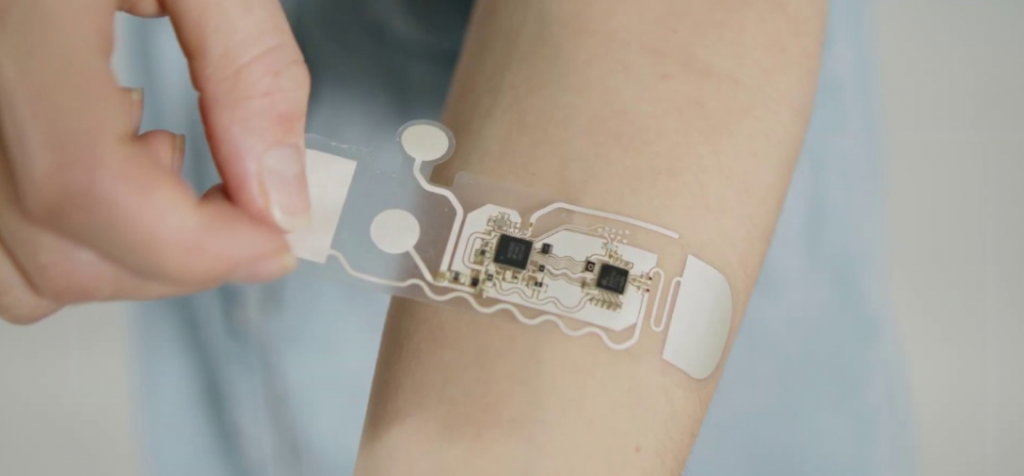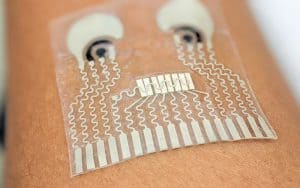
Printed Electronics – A Boon to Healthcare Innovation
The health sector is one of the segments that have the potential for printed and flexible electronics. The devastating COVID-19 scare continuously hovering over our minds has forced the Governments and Health Organizations to adopt innovative technology that can relieve pressure on medical professionals and improve treatment.
Since 2020, there have been notable examples of new products launched as a response to the pandemic; products that offer new opportunities soon for healthcare and enhanced patient comfort.
The COVID-19 crisis highlights the importance of monitoring patients comfortably and preferably in their home environment. We are seeing growth in Printed Electronics devices inspired, intelligent monitoring systems that are not attached to your body with cables. Such devices are small in size, lightweight, and have a form factor that is comfortable for the patient. Printed Electronics companies are on the upsurge because printed electronics are used prevalently in remote patient monitoring (RPM) devices in the healthcare sector and skin patches for monitoring ECG, EEG, and sleep diagnostics.
One of the significant advantages of RPM is cost savings, and it is predicted to save $200 billion within the next 25 years. The reduction of unnecessary visits, the better time spent with patients, and better communication are all advantages of remote monitoring of patients.
This article emphasizes why Printed and Flexible Electronics technology will rule the future of the electronics industry. Further, here we will get to know Printed Electronics examples used presently in the healthcare industry. This article is a perfect blend of knowledge resources and it’s application in the healthcare industry, which helps save lives by forecasting diseases.
Wearable Biosensors as Printed electronics in Medical Applications
Securing the cooperation of ill patients can be difficult for medical experts. Patients aren’t always able to report their symptoms correctly, and they may not be able to perform the tests prescribed by their doctor at home. Additionally, many patients overlook or ignore the first signs of health issues, even though seeking immediate treatment can improve their health.
Biosensors offer a feasible solution to a variety of issues. These are Wearable electronic devices, a more advanced feature of Printed Electronics; embedded into everyday objects, used to monitor vital signs and spot significant biological abnormalities. For instance:
· Heart rate
· Blood pressure
· Blood/Oxygen levels
· Temperature
Skin Patches as Printed Flexible Electronics for Monitoring Heart Rate
Printed Flexible wearable electronics, including Ion-sensor arrays, biosensor chips, or vital sensor patches, are receiving much interest due to their widespread use in the field of healthcare. Sensors made out of Printed Electronics technology operate continuously to ensure continuous monitoring of healthcare. Continuous monitoring is accomplished through the development of wearable sensors. These sensors are generally employed to analyze human movement in various applications, including pulse wave sensors and motion sensors to capture motion. Monitoring and analyzing any information about the human body’s physiology is crucial in academic and healthcare science.
Electronic skin patches provide an intriguing balance between the medical standards of 12 leads ECG testing and consumer electronics like smartwatches and fitness trackers in cardiac monitoring. Though electronic skin patches give little information than 12-lead ECG, skin patches offer more accurate and valuable information than optical technology found in fitness trackers and smartwatches. Skin Patches also provide continuous monitoring, in contrast to the single-lead ECG used in newer smartwatch models.

In medical settings, electronic skin patches provide greater mobility to patients over the 12 lead tests. The first step in 12 lead ECG involves an ECG Holter monitor, a portable wired device designed to be used for 24-48 hours. But, this device is bulky and challenging in case of portability.
To improve patient comfort, companies have created cardiac monitoring patches that take the form of a single connected device on a flexible substrate. By eliminating wires and reducing the area and weight, the electronic skin patches feel more comfortable. They can be used for extended monitoring times that can last for up to 30 days. This is crucial in detecting the occurrences of patients who don’t experience them regularly. The next stage for devices is to integrate printed electronics to produce integrated electrodes and devices with close-fitting designs to ensure greater comfort for patients.

In general, electronic skin patches eliminate the hassles of physically monitoring the patient. Using skin patches ensure accuracy, safety and saves patients’ traveling.
Electronic skin patches also eliminate using implantable monitors for cardiac health. Such monitors are accurate but less secure, expensive, and require frequent monitoring to check it’s worthiness. So the patient needs to travel to a medical center.
However, skin patches for monitoring cardiac health do not apply to monitoring events or mobile cardiac monitoring telemetry. Beyond cardiac monitoring, electronic skin patches are used for monitoring other conditions (e.g., respiratory), or general patient monitoring (in-patient, post-discharge, etc.) may also have cardiac monitoring capabilities.
Wearable Electronics for Monitoring Blood Pressure
Blood Pressure monitoring printed electronics wearable patch is a soft, stretchy patch of skin worn around the neck to monitor the heart rate and blood pressure. It also measures the wearer’s level of glucose, alcohol, lactate, or caffeine. This is the first device that can simultaneously monitor heart-related signals and multiple biochemical levels of the human body.
This type of wearable would be beneficial for people with underlying medical conditions to monitor their health regularly. It would also serve as an excellent tool for remote patient monitoring, especially during the COVID-19 pandemic when people minimize in-person visits to the clinic.
Such a device could benefit individuals managing high blood pressure and diabetes, who are also at high risk of becoming seriously ill with COVID-19. It is also possible to determine the start of sepsis. This condition is defined as rapid drops in blood pressure followed by a sudden rise in lactate levels. One patch on the skin that can do all of this can also provide a practical option for intensive care units. Especially, such devices may be used for children in the NICU(Newborn Intensive Care Unit) that require continuous checking of blood pressure and other vital indicators. These procedures are currently involving placing catheters in the arteries of patients and then monitoring patients.
The takeaway here is: we take completely different sensors and merge them on a single small platform as small as a stamp. We can collect so much information with this one wearable and do so in a non-invasive way, without causing discomfort or interruptions to daily activity.
Stretchable and Flexible Electronics as Skin Patch to measure body chemistry

It is a thin layer of stretchable polymers that adapt to the skin. It comes with sensors for blood pressure and two chemical sensors. One monitors the levels of lactate (a biomarker of physical exertion) and alcohol and caffeine present in the sweat, and the other measures the glucose levels in the interstitial fluid. This printed electronics-inspired patch can measure three variables at the same time and from each sensor. The parameters under scrutiny are blood pressure and glucose and also alcohol, lactate, or caffeine.

Real-time sweat analysis on the human body using flexible printed electronics substrate 
Using Electronic Patches for Sweat Analysis to determine alcohol, caffeine, lactate, glucose along with Blood Pressure
It is a thin layer of stretchable polymers that adapt to the skin. It comes with sensors for blood pressure and two chemical sensors. One monitors the levels of lactate (a biomarker of physical exertion) and alcohol and caffeine present in the sweat, and the other measures the glucose levels in the interstitial fluid. This printed electronics-inspired patch can measure three variables at the same time and from each sensor. The parameters under scrutiny are blood pressure and glucose and also alcohol, lactate, or caffeine.
Printed Electronics for Monitoring Blood-Oxygen Level
Ever wondered Printed Electronics technology would serve as an alternative to bulky Oximeters?
Let us understand Oximeters first. The healing process for injuries is dependent on the constant flow of blood’s most important ingredient, oxygen.
When you hear the word oximeter, the instrument to measure blood-oxygen levels, rigid and bulky finger-clip sensors come into your mind. But, there exists an option to this. Modern-day Oximeters are lightweight, thin, and flexible.

In contrast to fingertip oximeters, it can measure blood oxygen levels at nine grids locations and on any skin. It is possible to measure the amount of oxygen supplied in skin grafts or examine the skin to check oxygen levels in organs.
The wearable sensor, which employs printed electronics technology, is beneficial in cases that require oxygen monitoring in the blood. Patients sick with sleep apnea, diabetes, and even respiratory diseases can wear a sensor anywhere to monitor blood-oxygen levels all the time.
Current oximeters utilize light-emitting diodes (LEDs) to reflect near-infrared and red light across the skin to determine the amount of light made it to the opposite side. The oxygen-rich blood of red absorbs more light, infrared, and blood with lower oxygen levels takes in more light from the red. By analyzing the ratio of light transmitted, sensors will determine the amount of oxygen present in the blood.
These oximeters can only be used in regions of the body which are partly transparent, such as the fingertips and earlobes. They can test blood-oxygen levels at a specific point in the body.
Thick regions of the body, such as the forehead, arms, and legs, barely pass visible or near-infrared light, making measuring oxygenation at these locations challenging.
Since then, they’ve taken their research to the next level by developing a method of monitoring the oxygen levels in tissues through reflection rather than transmitted light. Printed organic LEDs could be used to construct small, flexible oximeters to be used on fingers or earlobes. Combining both technologies lets them develop a wearable sensor that can measure oxygen levels in blood anywhere in the body.
The sensor comprises a series of near-infrared and red organic LEDs and organic photodiodes printed onto the flexible substrate. The sensor measures the blood oxygen levels across the forehead of the patient who breathed air that had progressively smaller oxygen levels like going up in altitude. It was observed that it was comparable to the results that were measured using a conventional fingertip oximeter. The sensor also measures blood oxygen levels in the form of a three-by-three grid placed on a person’s forearms wearing the pressure cuff.
After transplantation, surgeons want to ensure that all parts of an organ are getting oxygen. If you have one sensor, you have to move it around to measure oxygen supply at different locations. With an array, you can know right away if a point is not healing properly.
Printed Electronics for Monitoring Body Temperature
The research and development of flexible sensors employing Printed Electronics have gradually intensified in the last few years. The performance of wearable sensors for monitoring the body’s temperature has also been improved. The human body’s temperature fluctuations provide information about health conditions, and irregular body temperature fluctuations typically signify an unhealthy state of health. To ensure real-time and accurate monitoring of the various temperature zones in the human body, researchers have developed a variety of types of high-sensitivity temperature sensors, which have improved the functions of a printed electronics skin patch. They’ve additionally proposed several practical applications.

Printed Electronics Flexible temperature sensors are heading towards being more user-friendly by evolving to be comfortable to wear, extremely sensitive to signals, lightweight and large-area, and accurate with real-time data. The flexible temperature sensor relies on the electrical signal changes in the thermo-sensitive materials due to the temperature change to enable the monitoring in real-time. The device also utilizes the material’s properties to stick completely to the skin to perform its purpose. Compared to conventional temperature measurement instruments, apart from being cumbersome to carry around and expensive, they are also not suited for monitoring. However, they have limitations because of the deliberate or non-intentional movements of the patient and the inability to track particular body spots (such as wounds and tumor ablation sites inside the body, which can result in inaccurate or faulty measurements. To solve the above issues, wearable, flexible thin, and sensitive patterned temperature sensors have emerged as an important research area for researchers.
In the last few times, research into temperature sensors that can be made flexible to monitor body temperature has continued to advance and accompanied numerous developments. Pattern-based fabrication to produce large-area flexible temperature sensors is now an increasingly popular trend and mimics the biological structure already available with nature. For example, the tentacles of the octopus have adsorption properties. The forked tongue of a snake detects variations in the temperature of the prey. The whisker-like structures of mammals and arthropods can detect temperature and clearly show the body temperature monitored by the sensor. Researchers use the flexible temperature sensor in an arrayed manner. An image sensor or its electrochromic material is used to display the thermal imaging mapping. The in-depth study of flexible temperature sensors will also offer adequate technical assistance for meeting high sensitivity requirements, such as temperature measurement.
Printed Electronics Technology for Remote Patient Monitoring
Remote patient monitoring (RPM) technology enhances traditional medical devices’ portability, convenience, and accessibility. The devices can be utilized in healthcare settings. However, their full potential can be realized outside of these settings, particularly in patients’ homes.
Telemedicine was growing before COVID-19 made its appearance worldwide. It’s a task for medical professionals to meet with a patient online. However, it’s a greater problem to conduct diagnosis and monitor virtually.
The implementation of RPM can increase the efficiency of convenience, efficiency, and cost-effectiveness of healthcare. Patients will reduce their time in hospitals (or other healthcare establishments) and still have peace of mind knowing that their doctor keeps an eye on their health data. In conjunction with more sophisticated health analytics, RPM could improve results in health and better living quality.
As the population increases and gets older and with the rising prevalence of chronic health problems, the healthcare system is in danger of being overburdened. One way to keep up with the demands and decrease costs is to use remote monitoring of patients.
In-home monitoring is particularly important for certain patients, including patients with chronic illnesses and infants, who undergo surgery or are recently released from medical treatment. RPM devices can serve a variety of applications, such as measuring levels of glucose, weight, blood pressure, heart rate and temperature, movement, the level of oxygen, medication tracking, and many more.
The most common use of Remote Patient Monitoring employing Printed Electronics is Flexible Sensing Resistors used in hospital beds to track patient movement. If the patient leaves the bed, the FSR senses the pressure change and activates an alarm to alert the healthcare staff.
Benefits of Flexible Printed Circuits
Remote monitoring of patients demands new technology to create medical devices as light, compact, and as comfortable as possible. In the same way, the design of products should be made with manufacturability and cost in mind to bring them to the market. Flexible printed electronics can address all of these problems and provide further design advantages.
Flexible printed electronics rely on printed conductive inks on flexible materials to form electronic circuits. This technique can substitute rigid circuit boards that add bulk, costs, and manufacturing steps.
Additionally, they are lighter, smaller, and more cost-effective. Printed electronics can also facilitate innovative, new design possibilities with flexible forms with wearable and stick-to-skin capabilities and wireless connectivity. In addition, thanks to advances in materials, the long-term durability of printed electronics can be competitive or, in some cases, even surpass conventional copper circuits.
Custom Converting to Printed Flexible Electronics
No doubt, remote monitoring of patients could be the next innovation in the medical industry. To incorporate flexible electronic components into your product, its essential to find an experienced manufacturing partner who may be skilled and knowledgeable about these complex parts.
At Linepro Controls, we are uniquely in a position to help bring your RPM device to life using flexible printed electronics, from design advice to material selection (including sticky-to-skin and inks with conductive properties) from printing to custom-designed converting.
The Printed Electronics hub for Remote Patient Monitoring Systems
At Linepro Controls, we have more than 20 years of expertise in helping our customers with their tough problems regarding products that employ Flexible and Printed Electronics. We have an advanced manufacturing facility dedicated to printed electronics. Please find out more about our flexible printed electronics solutions on www.lineproindia.com

